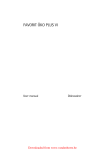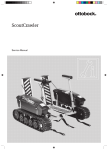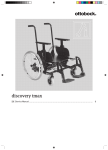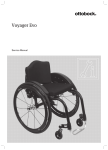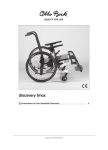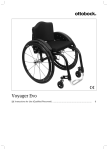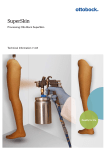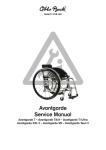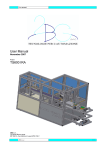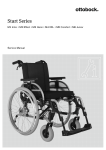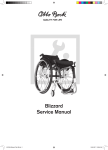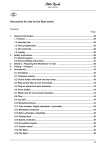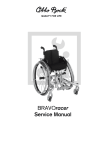Download Kimba neo - Ottobockdoc.se
Transcript
Kimba neo
Service Manual
Table of contents
Table of contents
1
1.1
1.2
1.3
Introduction .........................................................................................................................................................4
Foreword ............................................................................................................................................4
Support ...............................................................................................................................................4
Product Overview .................................................................................................................................5
2
2.1
2.2
Safety ....................................................................................................................................................................7
Explanation of Warning Symbols .............................................................................................................7
General Safety Instructions ....................................................................................................................8
3
3.1
3.2
3.3
3.4
3.5
3.5.1
3.5.1.1
3.5.1.2
3.5.1.3
3.5.2
3.5.2.1
3.5.2.2
3.5.2.3
3.5.2.4
3.5.2.5
3.5.2.6
3.5.3
3.5.3.1
3.5.3.2
3.5.4
3.5.4.1
3.5.4.2
3.5.4.3
3.5.4.4
3.5.5
3.5.5.1
3.5.5.2
3.5.5.3
3.5.5.4
3.5.5.5
3.5.6
3.5.6.1
3.5.6.2
3.5.7
3.5.7.1
3.5.7.2
3.5.7.3
3.6
3.6.1
3.6.1.1
3.6.1.2
3.6.1.3
3.6.1.4
3.6.1.5
Service Work .......................................................................................................................................................8
General Information ..............................................................................................................................8
Instructions for Adjustment.....................................................................................................................8
Maintenance Schedule ..........................................................................................................................9
Required Tools and Accessories .............................................................................................................9
Outdoor Mobility Base ...........................................................................................................................9
Rear Wheels ........................................................................................................................................9
Replacing the Rear Wheel .....................................................................................................................9
Replacing the Casing ............................................................................................................................9
Replacing the Tube (Pneumatic Tyre) ......................................................................................................9
Front Wheels ......................................................................................................................................10
Replacing a "Fixed" Front Wheel ..........................................................................................................10
Replacing a "Swivelling" Front Wheel ...................................................................................................10
Replacing the Caster Fork ...................................................................................................................10
Replacing the Swivel Lock ...................................................................................................................11
Replacing the Casing ..........................................................................................................................11
Replacing the Tube (Pneumatic Tyre) ....................................................................................................12
Seat Adapter ......................................................................................................................................12
Replacing the Seat Adjustment Mechanism (Porter Cylinder) ...................................................................12
Replacing the Seat Adapter (Tilt Activation on Standard Seat) ..................................................................13
Suspension/Rear Wheel Linkage ..........................................................................................................14
Replacing the Suspension....................................................................................................................14
Adjusting the suspension .....................................................................................................................14
Replacing the Complete Rear Wheel Linkage (incl. Wheel Lock) ..............................................................15
Replacing the Rear Wheel Linkage (Individual) .......................................................................................15
Frame ................................................................................................................................................16
Replacing the Front Frame ...................................................................................................................16
Replacing the Upper Front Frame .........................................................................................................17
Replacing the Front Frame (Complete) ..................................................................................................18
Replacing the Folding Tube..................................................................................................................18
Replacing the Fixed Tube Head ............................................................................................................19
Push Bar ............................................................................................................................................20
Replacing the Ratchet Joints with Folding Fixture ....................................................................................20
Replacing the Push Bar .......................................................................................................................20
Options/Accessories ...........................................................................................................................20
Replacing the Storage Basket ..............................................................................................................20
Replacing/Retrofitting the Tip-Assist ......................................................................................................21
Retrofitting the Respirator Platform ........................................................................................................21
Multifunctional Seating Unit (Standard Seat) ..........................................................................................23
Pads/Covers ......................................................................................................................................23
Replacing the Seat Pad .......................................................................................................................23
Replacing the Backrest Pad .................................................................................................................24
Replacing the Covers ..........................................................................................................................24
Replacing the Grab Rail Cover (Option).................................................................................................25
Replacing the Frame Padding (Option) ..................................................................................................25
2 | Ottobock
Kimba neo
Table of contents
3.6.2
3.6.2.1
3.6.2.2
3.6.2.3
3.6.2.4
3.6.2.5
3.6.2.6
3.6.2.7
3.6.3
3.6.3.1
3.6.3.2
3.6.3.3
3.6.3.4
3.6.3.5
3.6.4
3.6.4.1
3.6.5
3.6.5.1
3.6.5.2
3.6.5.3
3.6.5.4
3.6.6
3.6.6.1
3.6.6.2
Back..................................................................................................................................................26
Replacing the Back Insert ....................................................................................................................26
Replacing the Knob .............................................................................................................................27
Removing/Installing the Tilt Activation Mechanism ...................................................................................28
Replacing the Back Frame (Complete) ..................................................................................................29
Replacing the Lateral Supports .............................................................................................................30
Replacing the Headrest Supports .........................................................................................................30
Installing/removing the seat depth reducer .............................................................................................30
Footplate/Knee Angle Assembly ...........................................................................................................31
Replacing the Foot Plate ......................................................................................................................31
Replacing Small Parts on the Footplate .................................................................................................31
Replacing the Knee Angle Assembly (Complete).....................................................................................32
Replacing the Footplate Adapter ...........................................................................................................32
Replacing the "Seat Adjuster" ..............................................................................................................33
Base Frame (Seat Frame) ....................................................................................................................33
Replacing the Base Frame (Tilt Activation Mechanism on Seat) ................................................................33
Supports ............................................................................................................................................34
Replacing the Headrest Supports .........................................................................................................34
Replacing the Thoracic Supports ..........................................................................................................35
Replacing the Hip Supports .................................................................................................................35
Replacing the Lateral Supports .............................................................................................................36
Options/Accessories ...........................................................................................................................37
Replacing/Retrofitting Safety Belts and Positioning Systems ....................................................................37
Replacing/Retrofitting other Options......................................................................................................38
4
4.1
4.2
4.2.1
4.2.2
Appendices ........................................................................................................................................................39
Technical Data ....................................................................................................................................39
Maintenance Schedule ........................................................................................................................40
Maintenance Schedule – Outdoor Mobility Base .....................................................................................40
Seating Unit Maintenance Schedule ......................................................................................................41
Kimba neo
Ottobock | 3
Introduction
1 Introduction
1.1 Foreword
Regular maintenance is important – it improves safety and increases the lifespan of the product.
All Mobility products should be inspected and serviced once a year.
However, we recommend inspecting, readjusting, and if necessary servicing the product every 6 months if the
product is used frequently, by growing children or by users with changing clinical conditions.
Only use original spare parts for all service and maintenance work. The service and maintenance tasks described
here should only be completed by trained, qualified personnel and not by the user of the device.
This service and maintenance manual refers to the respective spare parts catalogues and the instructions for use of
the described products. Please use these documents together.
Use the maintenance schedule (checklist) as a template for making copies. Retain completed maintenance sched
ules and provide the customer with a copy.
Kimba neo
Instructions for Use (Qualified Per Instructions for Use (User)
sonnel)
647G771=*
647G770=*
1.2 Support
Your national Ottobock team will be happy to answer any technical questions. The contact addresses and tele
phone numbers can be found on the back inside cover of the service manual.
4 | Ottobock
Kimba neo
Introduction
1.3 Product Overview
1
Kimba Neo – outdoor mobility base with multifunctional seating unit and "swiveling" front wheels option
1 Plug-on rear wheel
6 Angle-adjustable backrest
2 "Swiveling" front wheel (option)
7 Adjustable push bar
3 Front lashing ring
8 Release handle, folding mechanism
4 Adjustable footrest
5 Removable seat with lateral supports
Kimba neo
9 Rear lashing ring
10 Suspension
Ottobock | 5
Introduction
2
Kimba neo – outdoor mobility base with multifunctional seating unit and "swiveling" front wheels option
1 Plug-on rear wheel
6 Adjustable push bar
2 "Swiveling" front wheel (option)
7 Release handle, folding mechanism
3 Swivel lock
8 Separate seat tilt feature on frame
4 Front lashing ring
5 Seat adapter
6 | Ottobock
9 Rear lashing ring
10 Suspension
Kimba neo
Safety
3
Kimba neo – outdoor mobility base with "fixed" front wheels
1 Plug-on rear wheel
5 Adjustable push bar
2 Plug-on "fixed" front wheel
6 Release handle, folding mechanism
3 Front lashing ring
7 Suspension
4 Seat adapter
8 Rear lashing ring
2 Safety
2.1 Explanation of Warning Symbols
WARNING
Warnings regarding possible risks of severe accident or injury.
CAUTION
Warnings regarding possible risks of accident or injury.
NOTICE
Kimba neo
Warnings regarding possible technical damage.
Ottobock | 7
Service Work
2.2 General Safety Instructions
CAUTION
Failure to observe installation instructions
Pinching, crushing due to installation errors
► Do not reach between force-actuated surfaces during installation work.
CAUTION
Use of unsuitable tools
Pinching, crushing or damaging the product
► When working, use only tools that are suitable for the conditions at the workplace and whose proper use
ensures safety and health protection.
CAUTION
Re-use of self-locking nuts
Unintended loosening of the screw connections
► Always replace self-locking nuts with new self-locking nuts after disassembly.
NOTICE
Tipping or falling of the product
Damage to the product
► When you work on the product, secure it so that it cannot tip over or fall over.
► Use a clamping device to secure the product for all work at a workbench.
3 Service Work
3.1 General Information
INFORMATION
Read the service manual before starting work. Familiarise yourself with the functions of the product prior to
inspection and use. In order to do so, you can request this service manual and other documentation from the
manufacturer (see the overview of national Ottobock branches on the inside of the back cover) or download from
our homepage www.ottobock.de or www.ottobock.com.
INFORMATION
Clean and disinfect the product before commencing service work.
Observe all care instructions and product-specific inspection instructions in the instructions for use.
INFORMATION
Many screw connections utilise screws and nuts equipped with thread lock. If you loosen screw connections, be
sure to replace the respective nut or screw with one equipped with a new thread lock. If new screws or nuts with
thread lock are not available, apply a medium-strength liquid thread locking compound (such as Loctite® 241 or
Euro Lock A24.20) to the existing screws.
3.2 Instructions for Adjustment
WARNING
Failure to verify tipping resistance
Risk of the user falling or tipping over
► Changing the settings can lead to instability of the system as a whole. Verify tipping resistance after any
changes to the settings.
The sections that follow describe the replacement and retrofitting of standard and option parts on the product
shown on the cover.
8 | Ottobock
Kimba neo
Service Work
All instructions concerning the adjustment of the parts installed are included in the Instructions for Use (qualified
personnel) – see the section "Foreword" for the order number.
3.3 Maintenance Schedule
Maintenance schedule as a template for copying: see Page 40.
3.4 Required Tools and Accessories
The following tools are required in order to perform the service work:
• Reversible ratchet handle wrench and sockets (size: 8 – 24)
• Torque wrench (measurement range 5 - 50 Nm)
• Wrench (size: 8 – 24)1)
• Allen wrench (size: 2.5 – 6)2)
• Screwdriver (blade width: 2.5/3.5/5 mm)
• Phillips head screwdriver (size: 2)
• Hammer (approx. 300 g); soft-faced hammer
• Pliers: cutting pliers, combination pliers, snap ring pliers
• Rivet gun (for rivets up to ø 5 mm)
• Pin punch, ø 3/4/5/6 mm
• Drill/twist drill ø 3.2/5/5.2/6 mm
• Stanley knife with sickle hooked blade and standard blade
• Tyre mounting levers and inner tube repair kit*
• Workbench and vice with plastic jaws and rubber insert
• Measurement equipment: rule, spirit level
• Liquid thread locker, "medium" and "strong"
1)
2)
Included in 481C08=ST010 Tool Set
Size 3 – 6 contained in the 481C08=ST010 Tool Set
3.5 Outdoor Mobility Base
3.5.1 Rear Wheels
3.5.1.1 Replacing the Rear Wheel
1) Release the wheel lock.
2) Press down the lock on the rear wheels (see Fig. 4).
3) Replace and reinstall the wheel. The locking mechanism must engage audibly.
4
5
3.5.1.2 Replacing the Casing
Replacing the casing on the rear wheel (see Fig. 6, Pos. 1) corresponds to replacing the casing on the caster
wheel: see Page 11.
3.5.1.3 Replacing the Tube (Pneumatic Tyre)
Replacing the tube on the rear wheel (see Fig. 6, Pos. 2) corresponds to replacing the tube on the caster wheel:
see Page 12.
Kimba neo
Ottobock | 9
Service Work
6
3.5.2 Front Wheels
3.5.2.1 Replacing a "Fixed" Front Wheel
1) After pushing down the locking mechanism, pull the front wheel off to the outside and replace it (not illus
trated).
2) Slide on the front wheel. The locking mechanism must engage audibly.
3.5.2.2 Replacing a "Swivelling" Front Wheel
1) Put the frame on its side.
2) Remove the caster wheel axle in the caster fork (see Fig. 7).
3) Remove and replace the caster wheel (see Fig. 8).
4) Tighten the caster wheel axle to a torque of 9 Nm.
7
8
3.5.2.3 Replacing the Caster Fork
1) Remove the caster wheel (see the preceding section).
2) Loosen the caster fork mounting screw (see Fig. 9).
3) Remove and replace the caster fork (see Fig. 10).
4) Install the caster fork with the supplied mounting materials.
5) Tighten the caster fork to a torque of 25 Nm.
10 | Ottobock
Kimba neo
Service Work
9
10
3.5.2.4 Replacing the Swivel Lock
1) Remove the caster wheel and caster fork (see the preceding sections; see Fig. 11).
2) Slide the swivel lock off the front frame and replace it (see Fig. 12).
3) Slide the swivel lock onto the front frame.
4) Install the caster fork and caster wheel (see the preceding section).
11
12
3.5.2.5 Replacing the Casing
1) Remove the wheel (see Page 10) and let out the air if required.
2) Using a tyre lever, remove the casing from the rim (see Fig. 13).
3) Remove the tube.
4) Replace the casing (see Fig. 14, Pos. 1).
5) Fill the inner tube with a small amount of air before mounting in order to avoid damage and pinching.
6) Install the casing on the rim with a tyre lever.
7) Reinstall the wheel (see Page 10).
13
Kimba neo
14
Ottobock | 11
Service Work
3.5.2.6 Replacing the Tube (Pneumatic Tyre)
1) Remove the wheel (see Page 10) and let out the air if required.
2) Using a tyre lever, remove the casing from the rim (see Page 11).
3) Replace or repair the tube (see Fig. 14, Pos. 2; see Fig. 15).
4) Fill the inner tube with a small amount of air before mounting in order to avoid damage and pinching.
5) Install the casing on the rim with a tyre lever.
6) Reinstall the wheel (see Page 10).
15
3.5.3 Seat Adapter
3.5.3.1 Replacing the Seat Adjustment Mechanism (Porter Cylinder)
1) Remove the Bowden cable from the porter cylinder:
→ Cut off the cable end sleeve (see Fig. 16, Pos. 1).
→ Loosen the screw die.
→ Remove the spring and Bowden cable guide (see Fig. 16, Pos. 2/3).
→ Unthread the Bowden cable on the Porter cylinder.
2) Unlock and remove the spring folding bolt on the Porter cylinder (see Fig. 17, Pos. 1).
3) Remove the retaining ring (see Fig. 17, Pos 2) and the bearing journal.
4) Remove and replace the Porter cylinder.
5) Install the Porter cylinder with the mounting materials provided (see Fig. 18). Note the following:
→ Apply oil/grease to the bearing journal prior to installation (see Fig. 18, Pos 1).
→ The piston rod of the Porter cylinder must not be lubricated (see Fig. 18, Pos 2).
→ Note the Bowden cable guide between the seat adjustment mechanism and the Porter cylinder (see
Fig. 19, Pos. 1).
6) Conduct a functional test. Pay particular attention to the functionality of the seat tilt feature and the seat tilt
mechanism in the tilted position.
16
12 | Ottobock
17
Kimba neo
Service Work
18
19
3.5.3.2 Replacing the Seat Adapter (Tilt Activation on Standard Seat)
INFORMATION
When replacing the seat adapter, the Bowden cable also has to be replaced. It is included with the mounting
materials provided with the seat adapter (see Fig. 23).
1)
2)
3)
4)
5)
Remove the Bowden cable on the Porter cylinder (see Page 12).
Unlock and remove the spring folding bolt on the porter cylinder (see Page 12).
Remove the Bowden cable on the seat adapter (see Fig. 20, Pos. 1).
Loosen the mounting screw on one side of the seat adapter (see Fig. 21, Pos. 1).
Remove the screw; insert a mounting aid (M8 screw with counter nut) in place of the screw that was removed
and install the counter nut (see Fig. 22, Pos. 1).
6) Loosen the mounting screw on the other side.
7) Remove the disassembly aid.
8) Remove and replace the seat adapter.
9) Install the seat adapter with the mounting materials provided (see Fig. 23). Tighten the seat adapter mounting
screws to a torque of 20 Nm:
10) Conduct a functional test. Pay particular attention to the functionality of the seat tilt feature and the seat tilt
mechanism in the tilted position.
20
Kimba neo
21
Ottobock | 13
Service Work
22
23
3.5.4 Suspension/Rear Wheel Linkage
3.5.4.1 Replacing the Suspension
1) Remove the plug-on rear wheel.
2) Put the frame on its side.
3) Loosen the suspension mounting screws (see Fig. 24, Pos. 1).
4) Remove and replace the suspension.
5) Install the suspension with the mounting materials provided (see Fig. 25). Tighten the mounting screws.
6) To adjust the spring force, see the following section.
24
25
3.5.4.2 Adjusting the suspension
The suspension can be adjusted continuously according to the user's weight and the conditions of the road/sur
face:
1) Twist the adjustment rings on both sides of the frame equally (see Fig. 26, item 1).
→ Clockwise: the suspension becomes tighter.
→ Counterclockwise: the suspension becomes softer.
2) Check that the adjustment rings are positioned the same on both sides. The 4 marks can be used for orienta
tion (see Fig. 26, item 2; see Fig. 27, item 1).
14 | Ottobock
Kimba neo
Service Work
26
27
We recommend the following setting for the spring tension:
User weight
up to 10 kg
up to 20 kg
up to 30 kg
up to 40 kg
Marking*
up to 1st marking from the top
up to 2nd marking from the top
up to 3rd marking from the top
up to 4th marking from the top
* Reference point: upper edge of the plastic adjustment nut
3.5.4.3 Replacing the Complete Rear Wheel Linkage (incl. Wheel Lock)
1) Remove the plug-on rear wheel.
2) Put the frame on its side.
3) Loosen the mounting screws between the rear wheel linkage and suspension (see Fig. 28, Pos. 1).
4) Loosen the mounting screws between the rear wheel linkage and lower front frame (see Fig. 28, Pos. 2).
5) Remove and replace the assembly "rear wheel linkage with wheel lock" (see Fig. 29).
6) Install the complete rear wheel linkage using the mounting materials provided (see Fig. 29). Tighten the mount
ing screws.
28
29
3.5.4.4 Replacing the Rear Wheel Linkage (Individual)
1) Remove the plug-on rear wheel.
2) Put the frame on its side.
3) Loosen the mounting screw between the rear wheel linkage and suspension (see Fig. 30, Pos. 1).
4) Loosen the mounting screw between the rear wheel linkage and lower front frame (see Fig. 30, Pos. 2).
5) Loosen the mounting screw on the axle stub (see Fig. 30, Pos. 3).
6) Disengage and replace the rear wheel linkage (see Fig. 31, Pos. 1). Ensure that the spring and lock bush of
the wheel lock are not ejected (see Fig. 31, Pos. 2).
7) Install the new rear wheel linkage with the mounting materials provided (see Fig. 32). Ensure that the bore hole
of the axle stub (see Fig. 31, Pos. 3) fits flush with the mounting bore of the rear wheel linkage (see Fig. 31,
Pos. 4).
8) Tighten the mounting screws: see Fig. 30, Pos. 1 – 3.
Kimba neo
Ottobock | 15
Service Work
30
31
32
3.5.5 Frame
3.5.5.1 Replacing the Front Frame
1) Remove the plug-on rear wheel.
2) Put the frame on its side.
3) Remove the caster wheels ("swivelling" front wheels: see Fig. 33; item 1; "fixed" front wheels: see Fig. 35).
4) Loosen the mounting screws between the rear wheel linkages and lower front frame (see Fig. 33, item 2; see
Fig. 35, item 2).
5) Using a spiral bit (Ø 5 mm), bore out 8 rivets between the lower/upper front frame (see Fig. 33, item 3; see
Fig. 35, item 3). Tap out the rivets with a pin punch (Ø 3 mm).
6) Remove and replace the front frame.
→ Front frame for swivelling front wheels (see Fig. 34)
→ Front frame for fixed front wheels (see Fig. 36)
7) Rivet/install the front frame with the mounting materials provided.
8) Tighten the mounting screws between the rear wheel linkages and lower front frame (see Fig. 33, item 2; see
Fig. 35, item 2).
9) Install the caster wheels (see Page 10 ff.).
16 | Ottobock
Kimba neo
Service Work
33
34
35
36
3.5.5.2 Replacing the Upper Front Frame
INFORMATION
The front frame is offered complete (see Fig. 37) and alternatively in a version without seat adapter.
1)
2)
3)
4)
5)
Remove the plug-on rear wheel.
Put the frame on its side.
Remove the caster wheels ("swivelling" front wheels: see Fig. 39; item 1; "fixed" front wheels: not illustrated).
Loosen the mounting screws on the suspension (see Fig. 24, item 1).
Only for front frame with seat adapter (see Page 13):
→ Remove the Bowden cable from the seat adapter (see Fig. 20).
→ Unlock and remove the spring folding bolt on the Porter cylinder (see Fig. 17, item 1).
6) Loosen the mounting screws between the folding tubes and fixed tube heads (see Fig. 38, item 1) and remove
the unit consisting of the folding tubes and push bar.
7) Using a spiral bit (Ø 5 mm), bore out 8 rivets between the lower/upper front frame (see Fig. 33, item 3) and tap
them out with a pin punch (Ø 3 mm).
8) Remove and replace the upper front frame (see Fig. 37).
9) Install/rivet the front frame.
10) Tighten the mounting screws.
→ see Fig. 38, item 1
→ see Fig. 24, item 1
11) Only for front frame with seat adapter: Reconnect the seat adapter-Bowden cable and the seat adapterPorter cylinder (see Page 13).
12) Install the caster wheels (see Page 10 ff.).
Kimba neo
Ottobock | 17
Service Work
37
38
3.5.5.3 Replacing the Front Frame (Complete)
1) Remove the plug-on rear wheel.
2) Put the frame on its side.
3) Remove the caster wheels ("swivelling" front wheels: see Fig. 39; item 1; "fixed" front wheels: not illustrated).
4) Loosen the mounting screws between the rear wheel linkages and lower front frame (see Fig. 39, item 2).
5) Loosen the mounting screws on the suspension (see Fig. 39, item 3).
6) Disconnect the front frame from the seat adjustment mechanism (see Page 13):
→ Remove the Bowden cable from the seat adapter (see Fig. 20).
→ Unlock and remove the spring folding bolt on the Porter cylinder (see Fig. 17, item 1).
7) Loosen the mounting screws between the folding tubes and fixed tube heads (see Fig. 38, item 1) and remove
the unit consisting of the folding tubes and push bar.
8) Remove and replace the front frame (see Fig. 40).
9) Install the front frame with the mounting materials provided.
10) Tighten the mounting screws.
→ see Fig. 38, item 1
→ see Fig. 39, item 2/3
11) Reconnect the seat adapter-Bowden cable and the seat adapter-Porter cylinder (see Page 13).
12) Install the caster wheels (see Page 10 ff.).
39
40
3.5.5.4 Replacing the Folding Tube
1) Bore out the rivet between the folding tube and ratchet joint (see Fig. 41, Pos. 1) and remove the ratchet joint.
2) Loosen the mounting screws on the suspension (see Fig. 41, Pos. 2).
3) Loosen the mounting screws between the folding tube and fixed tube head (see Fig. 41, Pos. 3).
4) Replace the folding tube.
5) Install the folding tube with the mounting materials provided (see Fig. 42). Tighten the mounting screws: see
Fig. 41, Pos. 2/3.
6) Rivet the ratchet joint to the folding tube (see Fig. 41, Pos. 1).
7) Attach the sticker to the folding tube.
18 | Ottobock
Kimba neo
Service Work
41
42
3.5.5.5 Replacing the Fixed Tube Head
1) Loosen the mounting screws on the suspension (see Fig. 24, Pos. 1).
2) Loosen the mounting screws between the folding tubes and fixed tube heads (see Fig. 38, Pos. 1) and remove
the unit consisting of the folding tubes and push bar.
3) Using a spiral bit (Ø 5 mm), bore out the rivet on the fixed tube head and tap it out with a pin punch (Ø 3 mm)
(see Fig. 43).
4) Tap out the fixed tube head from the upper front frame and replace it (see Fig. 44).
NOTICE! Damage to the fixed tube head. Only use the surface shown in the illustration for tapping the
component in or out.
5) Using a pin punch, press the fixed tube head into the upper front frame (see Fig. 45).
6) Rivet the fixed tube head (see Fig. 46).
7) Reinstall the folding tubes with push bar and the suspension.
8) Tighten the mounting screws.
→ see Fig. 38, Pos. 1
→ see Fig. 24, Pos. 1
Kimba neo
43
44
45
46
Ottobock | 19
Service Work
3.5.6 Push Bar
3.5.6.1 Replacing the Ratchet Joints with Folding Fixture
1) Using a spiral bit (Ø 5 mm), bore out 4 rivets on each ratchet joint and tap them out with a pin punch (Ø 3 mm)
(see Fig. 47, Pos. 1/2).
2) Remove and replace the ratchet joints (see Fig. 48).
3) Rivet the ratchet joint with the folding fixture on the correct side (see Fig. 49).
47
48
49
50
3.5.6.2 Replacing the Push Bar
1) Using a spiral bit (Ø 5 mm), bore out 2 rivets on each ratchet joint and tap them out with a pin punch (Ø 3 mm)
(see Fig. 47, Pos. 1).
2) Remove and replace the push bar (see Fig. 50).
3) Rivet the push bar onto the ratchet joint.
3.5.7 Options/Accessories
3.5.7.1 Replacing the Storage Basket
NOTICE
Incorrect attachment
Damage to the product
► During the attachment, make sure that the product cannot grind against the wheels.
1) Open the snap fasteners and hook-and-loop straps of the storage basket (see Fig. 51, Pos. 1; see Fig. 52,
Pos. 1).
2) Remove and replace the storage basket.
3) Mount the storage basket, with the proper side, to the frame using the snap fasteners and hook-and-loop
straps (see Fig. 51, Pos. 1; see Fig. 52, Pos. 1).
20 | Ottobock
Kimba neo
Service Work
51
52
3.5.7.2 Replacing/Retrofitting the Tip-Assist
1) Install the tip-assist on the lashing point at the rear with 2 mounting screws (see Fig. 53, item 1).
2) Firmly tighten the cap nuts (see Fig. 54, item 1).
53
54
3.5.7.3 Retrofitting the Respirator Platform
WARNING
Use in a wheelchair accessible vehicle is forbidden
Severe injury in case of accidents
► Use of the product in wheelchair accessible vehicles in combination with the artificial respiration platform
option is not permitted.
INFORMATION
The respiration platform cannot be used on a product with fixed front wheels.
Mounting instructions
• The option can be installed as follows:
– Installation of the large plate over the front wheels (see Fig. 55) – user sits in the seat facing opposite to the
direction of travel
– Installation of the large plate over the rear wheels (see Fig. 56) – user sits in the seat facing in the direction
of travel
• Using an anti-slip mat is recommended.
• Turning the seating unit is only possible if the respirator platform installation is changed.
• The respirator is attached to the respirator platform using straps through the slots.
Kimba neo
Ottobock | 21
Service Work
55
56
Installation with a seat facing opposite to the direction of travel
1) Glue the loop strap onto the front frame tube (see Fig. 57).
2) Firmly install the clamp fittings on the interior bores of the large plate (see Fig. 58, item 1).
3) Set the large plate onto the tube of the front frame (see Fig. 58, item 2).
4) Press the clamp fittings of the large plate onto the axle tube (see Fig. 58, item 3).
5) Set the small plate onto the front frame tube (see Fig. 60, item 1).
6) Thread the bearing bushings through the lashing points from the outside and firmly screw them to the small
plate (see Fig. 60, item 2).
57
58
59
60
Installation with a seat facing in the direction of travel
1) Glue the loop strap onto the front frame tube (see Fig. 57).
2) Pre-install the metal bracket on the large plate (see Fig. 62).
3) Set the large plate onto the front frame tube (see Fig. 63, item 1).
4) Thread the bearing bushings through the lashing points from the outside and firmly screw them to the large
plate (see Fig. 61, see Fig. 63, item 2).
22 | Ottobock
Kimba neo
Service Work
5) Set the small plate onto the front frame tube (see Fig. 64, item 1).
6) Set the small plate onto the axle tube (see Fig. 64, item 2).
61
62
63
64
3.6 Multifunctional Seating Unit (Standard Seat)
3.6.1 Pads/Covers
INFORMATION
The manufacturer offers two versions of the pads and covers with identical mounting:
► Pads/covers (standard)
► Pads/covers (microfibre)
3.6.1.1 Replacing the Seat Pad
1) Lift the seat pad and remove it from the hook-and-loop fastener on the seat plate (see Fig. 65).
2) Replace the seat pad.
3) Fit the seat pad onto the hook-and-loop fastener.
4) Push the seat pad under the hip supports (see Fig. 66).
65
Kimba neo
66
Ottobock | 23
Service Work
3.6.1.2 Replacing the Backrest Pad
INFORMATION
The manufacturer offers two versions of the backrest pad:
► Back pad for standard back insert (see Fig. 67)
► Back pad for back insert with head supports (see Fig. 68; to adjust the clearance of the integrated head sup
port: see Page 26)
1)
2)
3)
4)
5)
Release the twist lock of the backrest pad behind the seat bottom (see Fig. 69).
Unzip the backrest pad zipper (see Fig. 70) and remove/replace the backrest pad.
Put the backrest pad in place and pull it through between the back and seat bottom.
Close the twist lock (see Fig. 69).
Slide the backrest pad under the lateral supports (no illustration).
67
68
69
70
3.6.1.3 Replacing the Covers
INFORMATION
The manufacturer offers the covers in the following versions:
► Covers for headrest supports (see Fig. 71, Pos. 1)
► Covers for lateral supports (see Fig. 71, Pos. 2)
► Covers for thoracic supports (no illustration)
► Cover for the grab rail (see Fig. 71, Pos. 3; see the following section for replacement)
► Covers for hip supports (see Fig. 71, Pos. 4)
► Cover for the abductor (see Fig. 71, Pos. 5)
1)
2)
3)
4)
Remove the seat pad or backrest pad if required.
Open the hook-and-loop closure on the cover.
Remove the cover from the support or abductor and replace it.
Slide the cover over the support with proper alignment. Note the following:
→ If present: position the side reinforced with foam material on the outside (over the screw heads) (see
Fig. 72, Pos. 1).
24 | Ottobock
Kimba neo
Service Work
→ Pull the cover over the support starting with the side that does not have a lug (see Fig. 73, Pos. 1).
→ Pull the cover over the support with the help of the lug (see Fig. 73, Pos. 2).
→ Before fastening the hook-and-loop closure, push and fold down the lug (see Fig. 74).
5) Put the seat pad or backrest pad back into place.
71
72
73
74
3.6.1.4 Replacing the Grab Rail Cover (Option)
1) Push in the tripod spring and remove the grab rail (see Fig. 75, Pos. 1).
2) Pull the grab rail pad (see Fig. 71, Pos. 3) off the grab rail and replace it.
3) Slide the grab rail pad onto the grab rail (see Fig. 75).
4) Reattach the grab rail.
75
3.6.1.5 Replacing the Frame Padding (Option)
1) Open the hook-and-loop closure on the frame padding.
2) Remove and replace the frame padding.
3) Fit the frame padding around the push bar and close the hook-and-loop strap.
Kimba neo
Ottobock | 25
Service Work
4) Twist the hook-and-loop strap down and push the frame padding over the folding mechanism all the way to the
release handles (see Fig. 76).
76
3.6.2 Back
3.6.2.1 Replacing the Back Insert
INFORMATION
The manufacturer offers two versions of the back insert:
► Standard back insert: see Fig. 78
► Back insert with head supports: see Fig. 79
1)
2)
3)
4)
5)
Remove the backrest pad (see Page 24).
Loosen the 2 x set screws on the backrest tubes (see Fig. 77, Pos. 1).
Remove and replace the standard back insert (see Fig. 78) or the back insert with head supports (see Fig. 79).
Slide the new back insert into the back frame and adjust it to the desired height.
Tighten the set screws (see Fig. 77, Pos. 1).
INFORMATION: You can achieve a greater back height by additionally shifting the top back plate at
the back insert. To do so, loosen/remove the knurled nuts, shift the back plate and hand-tighten the
knurled nuts again.
6) Put the backrest pad in place (see Page 24).
Adapting the Back Insert with Integrated Head Supports
To adjust the clearance in the area of the head, up to 3 foam pads with a thickness of 1 cm each can be glued onto
the head supports (see Fig. 80, Pos. 1). They are included with the backrest pad.
77
26 | Ottobock
78
Kimba neo
Service Work
79
80
3.6.2.2 Replacing the Knob
INFORMATION
The manufacturer offers the knob and cover cap in the following single components:
► Seat angle adjustment knob: see Fig. 81, item 1
► Seat angle adjustment cover cap: see Fig. 82, item 1
► Back angle adjustment knob: see Fig. 81, item 2
► Back angle adjustment cover cap: see Fig. 82, item 2
Replacing the Seat Angle Adjustment Knob and Cover Cap
1) Using a screwdriver, carefully pry up the cover cap, remove and replace it (see Fig. 83).
2) Remove and replace the circlip (see Fig. 84).
3) Pull the knob off the centring pivot and replace it.
4) Install the knob using the mounting materials provided (see Fig. 81, item 1).
5) Tap the cover cap (see Fig. 82, item 1) into the knob.
81
Kimba neo
82
Ottobock | 27
Service Work
83
84
Replacing the Back Angle Adjustment Knob and Cover Cap
1) Using a screwdriver, carefully pry up the cover cap, remove and replace it (not illustrated).
2) Unscrew the knob from the mounting screw on the clamp tie-bar and replace it (see Fig. 117, item 1 – 3).
3) Reinstall the knob (see Fig. 81, item 2).
4) Using a rubber hammer, tap the cover cap (see Fig. 82, item 2) into the knob.
85
3.6.2.3 Removing/Installing the Tilt Activation Mechanism
INFORMATION
Removing/installing the tilt activation mechanism is required to replace the back frame and base frame (seat
frame).
Removing the Tilt Activation Mechanism
1) Remove the backrest pad (see Page 24).
2) Remove the back insert (see Page 26).
3) Remove the cover cap and knob (see preceding section).
4) Pry the back of the Bowden cable adapter (see Fig. 86, Pos. 1) off the adapter on the back plate (see Fig. 86,
Pos. 2).
5) Remove the round piece from the Bowden cable adapter (see Fig. 87, Pos. 1).
6) If required, disconnect the Bowden cable from the round piece (see Fig. 87, Pos. 2).
7) Cut open and remove the cable ties on the back frame (see Fig. 88, Pos. 1).
8) Pull the Bowden cable down through the back frame (see Fig. 89, Pos. 1).
→ Now the back frame and base frame (seat frame) can be replaced.
Installing the Tilt Activation Mechanism
1) After installing the back frame or base frame (seat frame), reinstall the tilt activation mechanism.
2) Note the following:
→ With the help of cable ties, install the Bowden cable so that it cannot be pinched/damaged (see
Fig. 88/see Fig. 89).
28 | Ottobock
Kimba neo
Service Work
→ During assembly, firmly press the Bowden cable adapter into the adapter on the back plate (see Fig. 86,
Pos. 1/2).
86
87
88
89
3.6.2.4 Replacing the Back Frame (Complete)
1) Remove the backrest pad (see Page 24).
2) Remove the back insert (see Page 26).
3) Remove the tilt activation mechanism (see Page 28).
4) Loosen the 4 x mounting screws on the back frame-base frame connection (see Fig. 90, Pos. 1/2).
5) Remove the 4 x bearing bushings (see Fig. 90, Pos. 3).
6) Separate the back frame from the base frame and replace it.
7) Install the back frame using the mounting materials provided (see Fig. 91).
8) Tighten the mounting screws.
INFORMATION: Tighten the screw connections so that there is no play between the mounting ele
ments. Take care, however, not to deform any components. Then check the movability of the connec
ted frame components and readjust the tightness of the screw connections as necessary.
9) Reinstall the tilt activation mechanism (see Page 28) and the back insert (see Page 26).
10) Reinstall the backrest pad (see Page 24).
Kimba neo
Ottobock | 29
Service Work
90
91
3.6.2.5 Replacing the Lateral Supports
To install the lateral supports: see Page 36.
3.6.2.6 Replacing the Headrest Supports
To install the headrest supports: see Page 34.
3.6.2.7 Installing/removing the seat depth reducer
INFORMATION
The seat depth of the multifunctional seating unit in size 1 can be reduced by 5 cm to 14 cm with the seat depth
reducer.
Installing the seat depth reducer
1) Remove the covers.
2) Remove the hip pads (see Page 35).
3) Remove the back frame. In order to do so, loosen the four mounting screws on the back frame – base frame
connection (see Fig. 90, item 1/2) and remove the four bearing bushings (see Fig. 90, item 3).
4) Attach the seat depth reducer with two mounting screws and two bearing bushings to the base frame (see
Fig. 92, item 1; see Fig. 93, item 1).
INFORMATION: In doing so, secure the mounting screws with a medium-strength liquid thread lock
compound (see Fig. 94).
5) Install the back frame with two mounting screws and two bearing bushings to the seat depth reducers (see
Fig. 92, item 2; see Fig. 93, item 2).
INFORMATION: In doing so, secure the mounting screws with a medium-strength liquid thread lock
compound (see Fig. 94).
6) Attach the hip pads and pull over the covers.
Removing the seat depth reducer
1) Remove the covers.
2) Remove the hip pads (see Page 35).
3) Loosen and remove the four mounting screws on each seat depth reducer (see Fig. 92, item 1/2). Remove the
bearing bushings.
→ The back frame is now separated from the base frame.
4) Attach the back frame with the bearing bushings inserted (see Fig. 90, item 3) to the base frame (see Fig. 95,
item 1) using two mounting screws (see Fig. 90, item 1/2).
5) Attach the hip pads and pull over the covers.
30 | Ottobock
Kimba neo
Service Work
92
93
94
95
3.6.3 Footplate/Knee Angle Assembly
3.6.3.1 Replacing the Foot Plate
1) Recommendation: Set the knee angle assembly horizontal.
2) Loosen the mounting screws in the slides (see Fig. 96). Ensure that the inserted flange nuts (see Fig. 97,
Pos. 2) do not fall out of the slides in the process.
3) Remove the footplate from the footplate adapter (see Fig. 96, Pos. 2) and replace it.
4) Slide the footplate onto the footplate adapter.
5) Tighten the mounting screws in the sliders to a torque of 5 Nm.
96
97
3.6.3.2 Replacing Small Parts on the Footplate
Replacing the Sliders
1) Remove the footplate.
2) Loosen the mounting screws on the sliders (see Fig. 98).
3) Remove and replace the sliders.
4) Tighten the mounting screws on the sliders to a torque of 5 Nm.
Kimba neo
Ottobock | 31
Service Work
Replacing the Flange Nut on a Slider
1) Loosen the mounting screws in the sliders (see Fig. 97, Pos. 1).
2) Remove the inserted flange nuts (see Fig. 97, Pos. 2) from the sliders and replace them.
3) Secure the flange nuts with the mounting screws.
98
3.6.3.3 Replacing the Knee Angle Assembly (Complete)
1) Remove the seating unit from the outdoor mobility base.
2) Loosen the 2 x knurled nuts on the underside of the base frame (see Fig. 99, Pos. 1).
3) If required: Loosen the 2 x knurled nuts on the rear mounting screws on the hip supports (see Fig. 111).
4) Pull the knee angle assembly (complete) out of the base frame and replace it (see Fig. 100).
5) Remove the footplate from the footplate adapter (see Page 31).
6) Slide the knee angle assembly (complete) back into the base frame and mount it.
7) Slide the footplate onto the footplate adapter (see Page 31).
8) Hand-tighten the knurled nuts.
99
100
3.6.3.4 Replacing the Footplate Adapter
1) Remove the footplate (see Page 31).
2) Remove the knee angle assembly from the base frame (see Page 32).
3) Loosen the pivoted levers (see Fig. 101, Pos. 1) from the end pieces of the "seat adjuster" (see Fig. 101,
Pos. 2).
4) Open the clamping lever (see Fig. 101, Pos. 3) and pull the footplate adapter (5see Fig. 101, Pos. 4) from the
struts (see Fig. 101, Pos. 5).
5) Pull the struts from the end pieces of the "seat adjuster" (see Fig. 101, Pos. 5/2).
6) Prepare the new footplate adapter (see Fig. 102).
7) Insert the struts into the end pieces of the "seat adjuster" (see Fig. 102, Pos. 1).
8) Slide the footplate adapter onto the struts (see Fig. 102, Pos. 2).
9) Engage the clamping lever (see Fig. 102, Pos. 3).
10) Mount the pivoted levers (see Fig. 102, Pos. 4) on the end pieces of the "seat adjuster" with the mounting
screws (see Fig. 101, Pos. 1/2).
32 | Ottobock
Kimba neo
Service Work
11) Mount the footplate (see Page 31).
12) Mount the knee angle assembly on the base frame (see Page 32).
101
102
3.6.3.5 Replacing the "Seat Adjuster"
1) Remove the footplate (see Page 31).
2) Remove the knee angle assembly from the base frame (see Page 32).
3) Loosen the footplate adapter with struts from the end pieces of the "seat adjuster" (see Page 32).
4) Replace the "seat adjuster" (see Fig. 102, Pos. 5).
5) Insert the struts into the end pieces of the "seat adjuster" (see Fig. 102, Pos. 1).
6) Slide the footplate adapter onto the struts (see Fig. 102, Pos. 2).
7) Engage the clamping lever (see Fig. 102, Pos. 3)
8) Mount the pivoted levers (see Fig. 102, Pos. 4) on the end pieces of the "seat adjuster" with the mounting
screws (see Fig. 101, Pos. 1/2).
9) Mount the footplate (see Page 31).
10) Mount the knee angle assembly on the base frame (see Page 32).
3.6.4 Base Frame (Seat Frame)
3.6.4.1 Replacing the Base Frame (Tilt Activation Mechanism on Seat)
INFORMATION
The tilt activation mechanism must be removed prior to replacement (see Page 28).
1) Remove the seat pad (see Fig. 70).
2) Remove the seating unit.
3) Loosen the 4 x knurled nuts on the underside of the seat (see Fig. 111, Pos. 1) and remove the hip supports.
4) Pull the knee angle assembly out of the base frame (see Fig. 104).
5) Remove the back insert (see Page 26).
6) Remove the Bowden cable of the tilt activation mechanism from the back frame (see Page 28).
7) Loosen the 4 x mounting screws on the back frame-base frame connection (see Fig. 104, Pos. 1/2).
8) Remove and replace the base frame (see Fig. 105).
9) Mount the back frame on the base frame (see Fig. 104, Pos. 1/2; see Page 29).
10) Reinstall the Bowden cable of the tilt activation mechanism (see Page 28).
11) Reinstall the back insert (see Page 26).
12) Reinstall the backrest pad (see Page 24).
Kimba neo
Ottobock | 33
Service Work
103
104
105
3.6.5 Supports
3.6.5.1 Replacing the Headrest Supports
1) With a standard pad: Open the zipper at the top of the pad (see Fig. 70) and fold the backrest pad forward.
With a microfibre pad: Open the zipper. Do not fold down the pad; the supports must be threaded through
the slits in the pad for installation.
2) Loosen the knurled nuts on the back of the back plate (see Fig. 106).
3) Remove the mounting screws and supports.
4) Remove the covers from the supports (see Page 24) and replace the supports.
5) Pull the covers over the new supports with proper alignment (see Page 24).
6) Preinstall the supports on the correct sides with the mounting materials provided (see Fig. 107).
INFORMATION: With a microfibre pad, the supports first have to be threaded through the slits in the
backrest pad.
7) Put the mounting screws through the slotted hole in the support and the bore hole in the back insert, respect
ively (see Fig. 108).
INFORMATION: If the headrest supports are to be mounted to the top holes (= mounting points of the
back plate), the longer mounting screws, which come with the device, will have to be used instead of
the regular mounting screws.
8) Fasten the headrest supports on the back of the back plate using the knurled nuts (see Fig. 106). Adjust the
width in the slotted holes if required.
9) Hand-tighten the knurled nuts.
10) With a standard pad: Fold the backrest pad back over the supports and close the zipper.
With a microfibre pad: Close the zipper.
34 | Ottobock
Kimba neo
Service Work
106
107
108
3.6.5.2 Replacing the Thoracic Supports
1) Open the zipper at the top of the pad (see Fig. 70) and fold the backrest pad forward.
2) Loosen the knurled nuts on the back of the back plate (no illustration).
3) Remove the mounting screws and supports.
4) Remove the covers from the supports (see Page 24) and replace the supports.
5) Pull the covers over the new supports with proper alignment (see Page 24).
6) Preinstall the supports on the correct sides with the mounting materials provided (see Fig. 109).
7) Put the mounting screws through the slotted holes in the support and the slotted holes in the back frame/back
insert, respectively (see Fig. 110, Pos. 1).
8) Fasten the thoracic supports on the back of the back insert using knurled nuts. If necessary, adjust the
width/height.
9) Hand-tighten the knurled nuts.
10) Fold the backrest pad back over the supports and close the zipper.
109
110
3.6.5.3 Replacing the Hip Supports
1) Remove the seat pad (see Fig. 70).
Kimba neo
Ottobock | 35
Service Work
2)
3)
4)
5)
6)
Remove the covers from the supports (see Page 24).
Loosen the 4 x knurled nuts on the underside of the seat (see Fig. 103, Pos. 1).
Remove the mounting screws and supports.
Preinstall the supports on the correct sides with the mounting materials provided (see Fig. 112).
Put the mounting screws through the slotted holes in the support and the slotted holes in the base frame (seat
frame) and the front seat plate, respectively (see Fig. 113).
7) Mount the hip supports on the underside of the seat using knurled nuts (see Fig. 103, Pos. 1).
8) Adjust the seat width by moving the hip supports (see Fig. 113). This also allows for abducted settings. Handtighten the knurled nuts.
9) Adjust the depth of the supports if required (see Fig. 114). Tighten the mounting screws.
10) Pull the covers over the supports with proper alignment (see Page 24).
11) Replace the seat pad and secure it with the hook-and-loop fastener (see Fig. 70).
111
112
113
114
3.6.5.4 Replacing the Lateral Supports
1) Open the zipper at the top of the pad (see Fig. 70) and remove the backrest pad (see Page 24).
2) Remove the covers from the supports (see Page 24).
3) Remove the back insert (see Page 26).
4) Remove and set aside the back frame (see Page 29).
5) Remove the back plate from the back frame:
→ Using a spiral bit (Ø 5 mm), bore out 4 rivets between the back frame and back plate (see Fig. 115, Pos. 1)
and tap them out with a pin punch (Ø 3 mm).
→ Remove the 4 x Phillips screws between the back frame and back plate (see Fig. 115, Pos. 2)
→ Remove the 2 x set screws from the tube clamp (see Fig. 116, Pos. 1).
→ Remove the knob (see Fig. 85, Pos. 1) and the mounting screw (see Fig. 85, Pos. 2) from the clamp tie-bar
(see Fig. 85, Pos. 3).
→ Pull the back plate off the back frame.
6) Pull the tubes of the back frame (see Fig. 116, Pos. 2) from the lateral pads (see Fig. 116, Pos. 3) and the
plastic slides of the clamp tie-bar (see Fig. 116, Pos. 4).
7) Replace the lateral supports (see Fig. 118).
36 | Ottobock
Kimba neo
Service Work
8) Push the tubes of the back frame (see Fig. 116, Pos. 2) through the lateral supports (see Fig. 116, Pos. 3) and
the plastic slides of the clamp tie-bar (see Fig. 116, Pos. 4) on the back plate.
9) Rivet and screw the back plate in place.
10) Use the mounting screw to install the knob (including back securing bolt: see Fig. 85, Pos. 4) on the clamp tiebar.
11) Reinstall the back frame (see Page 29).
12) Install the back insert (see Page 26).
13) Pull the covers over the supports with proper alignment (see Page 24).
14) Reattach and close the backrest pad (see Page 24).
115
116
117
118
3.6.6 Options/Accessories
3.6.6.1 Replacing/Retrofitting Safety Belts and Positioning Systems
For the installation of the following add-on components, see the Instructions for Use (Qualified Personnel) – order
number 647G771:
• Safety belts:
– Strap guide
– Lap belt
– Four-point belt
– Five-point belt
• Positioning aids:
– Abductor
– Chest and shoulder support
– Fixation vest
– Groin strap
– Hook-and-loop foot straps
– Pelvic band (for installation information, consult the instructions that come with the product)
Kimba neo
Ottobock | 37
Service Work
3.6.6.2 Replacing/Retrofitting other Options
For the installation of the following options, see the Instructions for Use (Qualified Personnel) – order number
647G771:
• Canopy adapter
• Summer/winter slipsack
• Anti-slip lining
• Neck support
• Lumbar pad
• Padding
For the installation of the following options, see the Instructions for Use (User) – order number 647G770:
• Canopy
• Rain cover
• Armrests
• Grab rail
• Tray
• Cup holder
• Buggy Board
• Incontinence cover
• Foot block for shortening the lower leg length
38 | Ottobock
Kimba neo
Appendices
4 Appendices
4.1 Technical Data
Dimensions (cm) and weights (kg)
Outdoor mobility base
Overall width
Front wheel diameter, "swiveling" front wheels
Front wheel diameter, "fixed" front wheels
Rear wheel diameter
Push handle height (min./max.)
Seat tilt (seating unit angle (min./max.))
Max. load capacity2)
Max. load storage basket2)
Weight of mobility base
Folded size without seat (LxWxH)
Min. folded size with seat facing forwards; seat tilted
backwards 10°, back angle 100° (LxWxH)
Size 1
60
17
28
28
71/116
-35°/+10° or -10°/+35°
55
7
10.5
79x60x47
90x60x533)
Multifunctional seating unit
Size 1
Seat width
20 – 30
Seat depth
19 – 31
with seat depth reducer (option)
possible from 14 cm
Backrest height
41 – 61
Backrest angle
80° – 180°
Height of shoulder strap slots (min./max.)
30/45
Width of shoulder strap slots
5
Lower leg length
19 – 31
2)
Max. load capacity
40
Max. load capacity for use in a wheelchair accessible 40
vehicle4)
Weight
7
Folded size with lateral padding (LxWxH)
58x37x42
Size 21)
70
17
--28
71/116
-35°/+10° or -10°/+35°
55
7
11.5
79x67x47
97x67x59
Size 2
26 – 35
24 – 40
56 – 70
80° – 180°
30/45
5
20 – 37
40
40
8.5
59x43x58
1)
The outdoor mobility base with fixed front wheels in size 2 is available only as a custom fabrication.
The load capacity differs between the outdoor mobility base and the seating unit:
• Seating unit (max. 40 kg) + own weight of the seating unit, size 1 (7.5 kg) = 47.5 kg
• Outdoor mobility base (max. 55 kg) – fully loaded seating unit (47.5 kg) = 7.5 kg for other accessories + weight
in storage basket
3) Folded dimensions of the outdoor mobility base with fixed front wheels: 97x60x53 cm.
4) Observe the information in the section "Use in a Wheelchair Accessible Vehicle".
2)
Kimba neo
Ottobock | 39
Appendices
4.2 Maintenance Schedule
4.2.1 Maintenance Schedule – Outdoor Mobility Base
Maintenance Schedule
Item
Area
Kimba neo (outdoor mobility base)
Inspection (checklist)
Serial number:
Function/setting
(depending on equipment)
Tyres (wear)
Air pressure (only with pneumatic
tyres)
Fork/caster wheel axles
Swivel lock mechanism
Running behaviour of the wheels
(concentricity)
Tyres (wear)
Air pressure (only with pneumatic
tyres)
Bearings
Quick-release lock
Running behaviour of the wheels
(concentricity)
Ratchet mechanism
Seat adapter
Porter cylinder
Porter cylinder ease of operation
Angle adjustment lock
Bowden cable
Stability
Spring tension
Mounting points
Wheel lock mechanism
Wheel lock operation
Rivet joints/screw connections
Mounting points
Folding tube/fixed tube head
Folding mechanism
Ratchet joints
Angle adjustment
Push bar cover
1
2
3
Caster wheels
Rear wheels
Seat adapter/seat
adjustment
4
Suspension/rear
wheel linkage (with
wheel lock)
5
Frame
6
Push bar
Accessories
7
Storage bag
Do the wheelchair settings match the user's requirements?
The maintenance service was performed by:
* For some components: rivet joints or attachment checked
40 | Ottobock
Customer:
Inspected for dam
age/deformation
x
x
Screw connections
inspected*
X
x
x
x
x
x
x
x
x
x
x
x
x
x
x
x
x
x
x
x
x
x
x
x
x
x
x
x
x
x
x
x
x
x
x
x
x
x
x
x
x
x
x
x
x
x
on:
Kimba neo
Appendices
4.2.2 Seating Unit Maintenance Schedule
Maintenance Schedule
Item
Area
Kimba neo (multifunctional seating
unit)
Inspection (checklist)
Customer:
Serial number:
Function/setting
Inspected for dam
(depending on equipment)
age/deformation
1
Pads/covers
Surface (wear)
x
Closures
x
2
Back frame
Angle adjustment (clamping)
x
Back insert
x
Knob (attachment + function)
x
Clamp tie-bar
x
Tilt activation mechanism/Bowden
x
cable
3
Footplate
Height setting
x
Footplate lock
x
4
Knee angle assembly Depth adjustment
x
Angle adjustment
x
Struts/clamping lever
x
5
Base frame (seat
Clamping of the knee angle
x
frame)
assembly
Quick-release lock
x
Seat angle adjustment activation
x
mechanism
Bowden cable
x
Seat adapter (engages audibly)
x
6
Standard supports
Width adjustment
x
Padding
x
Accessories
7
Armrests
Tripod springs (locking mechanism)
x
8
Grab rail/padding for Tripod springs (locking mechanism)
x
grab rail
Surface (wear)
x
9
Pelvic band
Toothed belt (locking mechanism)
x
10
Canopy/canopy
Angle adjustment
x
adapter
Plug connection to the adapter
x
Ratchet function
x
11
Tray
Tripod springs (locking mechanism)
x
Angle adjustment
x
Depth adjustment
x
12
Thoracic supports
Width adjustment
x
Height adjustment
x
13
Chest and shoulder Attachment buckles
x
support
Seams
x
14
Fixation vest
Attachment straps
x
15
Belts (4/5-point)
Attachment and strap guide buckles
x
Seams/belting
x
Buckle
x
16
Abductor
Depth adjustment
x
Do the wheelchair settings match the user's requirements?
The maintenance service was performed by:
Kimba neo
Screw connections
inspected
x
x
x
x
x
x
x
x
x
x
x
x
x
x
x
x
x
x
x
x
x
x
x
x
x
x
x
x
x
x
x
on:
Ottobock | 41
42 | Ottobock
Kimba neo
Kundenservice/Customer Service
Europe
Otto Bock HealthCare Deutschland GmbH
Max-Näder-Str. 15 · 37115 Duderstadt · Germany
T +49 5527 848-3433 · F +49 5527 848-1460
[email protected] · www.ottobock.de
Otto Bock Healthcare Products GmbH
Kaiserstraße 39 · 1070 Wien · Austria
T +43 1 5269548 · F +43 1 5267985
[email protected] · www.ottobock.at
Otto Bock Adria Sarajevo D.O.O.
Omladinskih radnih brigada 5
71000 Sarajevo · Bosnia-Herzegovina
T +387 33 766200 · F +387 33 766201
[email protected] · www.ottobockadria.com.ba
Otto Bock Bulgaria Ltd.
41 Tzar Boris III‘ Blvd. · 1612 Sofia · Bulgaria
T +359 2 80 57 980 · F +359 2 80 57 982
[email protected] · www.ottobock.bg
Otto Bock Suisse AG
Pilatusstrasse 2 · CH-6036 Dierikon
T +41 41 455 61 71 · F +41 41 455 61 70
[email protected] · www.ottobock.ch
Otto Bock ČR s.r.o.
Protetická 460 · 33008 Zruč-Senec · Czech Republic
T +420 377825044 · F +420 377825036
[email protected] · www.ottobock.cz
Otto Bock Iberica S.A.
C/Majada, 1 · 28760 Tres Cantos (Madrid) · Spain
T +34 91 8063000 · F +34 91 8060415
[email protected] · www.ottobock.es
Otto Bock France SNC
4 rue de la Réunion - CS 90011
91978 Courtaboeuf Cedex · France
T +33 1 69188830 · F +33 1 69071802
[email protected] · www.ottobock.fr
Otto Bock Healthcare plc
32, Parsonage Road · Englefield Green
Egham, Surrey TW20 0LD · United Kingdom
T +44 1784 744900 · F +44 1784 744901
[email protected] · www.ottobock.co.uk
Otto Bock Hungária Kft.
Tatai út 74. · 1135 Budapest · Hungary
T +36 1 4511020 · F +36 1 4511021
[email protected] · www.ottobock.hu
Otto Bock Adria d.o.o.
Dr. Franje Tuđmana 14 ·10431 Sveta Nedelja · Croatia
T +385 1 3361 544 · F +385 1 3365 986
[email protected] · www.ottobock.hr
OOO Otto Bock Service
p/o Pultikovo, Business Park „Greenwood“,
Building 7, 69 km MKAD
143441 Moscow Region/Krasnogorskiy Rayon
Russian Federation
T +7 495 564 8360 · F +7 495 564 8363
[email protected] · www.ottobock.ru
Otto Bock HealthCare
Two Carlson Parkway North, Suite 100
Minneapolis, MN 55447 · USA
T +1 763 553 9464 · F +1 763 519 6153
[email protected]
www.ottobockus.com
Otto Bock Scandinavia AB
Koppargatan 3 · Box 623 · 60114 Norrköping · Sweden
T +46 11 280600 · F +46 11 312005
[email protected] · www.ottobock.se
Asia/Pacific
Otto Bock Slovakia s.r.o.
Röntgenova 26 · 851 01 Bratislava 5 · Slovak Republic
T +421 2 32 78 20 70 · F +421 2 32 78 20 89
[email protected] · www.ottobock.sk
Otto Bock Sava d.o.o.
Industrijska bb · 34000 Kragujevac · Republika Srbija
T +381 34 351 671 · F +381 34 351 671
[email protected] · www.ottobock.rs
Otto Bock Ortopedi ve
Rehabilitasyon Tekniği Ltd. Şti.
Ali Dursun Bey Caddesi · Lati Lokum Sokak
Meriç Sitesi B Block No: 6/1
34387 Mecidiyeköy-İstanbul · Turkey
T +90 212 3565040 · F +90 212 3566688
[email protected] · www.ottobock.com.tr
Africa
Otto Bock Algérie E.U.R.L.
32, rue Ahcène Outaleb - Coopérative les Mimosas
Mackle-Ben Aknoun · Alger · DZ Algérie
T +213 21 913863 · F +213 21 913863
[email protected] · www.ottobock.fr
Otto Bock Australia Pty. Ltd.
Suite 1.01, Century Corporate Centre
62 Norwest Boulevarde
Baulkham Hills NSW 2153 · Australia
T +61 2 8818 2800 · F +61 2 8814 4500
[email protected] · www.ottobock.com.au
Beijing Otto Bock Orthopaedic Industries Co., Ltd.
B12E, Universal Business Park
10 Jiuxianqiao Road, Chao Yang District
Beijing, 100015, P.R. China
T +8610 8598 6880 · F +8610 8598 0040
[email protected]
www.ottobock.com.cn
Otto Bock Asia Pacific Ltd.
Unit 1004, 10/F, Greenfield Tower, Concordia Plaza
1 Science Museum Road, Tsim Sha Tsui
Kowloon, Hong Kong · China
T +852 2598 9772 · F +852 2598 7886
[email protected] · www.ottobock.com
Otto Bock HealthCare India
Behind FairLawn Housing Society
St. Gregorios Lane, Sion Trombay Road
Chembur, Mumbai, 400071 · India
T +91 22 2520 1268 · F +91 22 2520 1267
[email protected] · www.ottobock.in
Otto Bock Egypt S.A.E.
28 Soliman Abaza St. Mohandessein - Giza · Egypt
T +202 330 24 390 · F +202 330 24 380
[email protected] · www.ottobock.com.eg
Otto Bock Japan K. K.
Yokogawa Building 8F, 4-4-44 Shibaura
Minato-ku, Tokyo, 108-0023 · Japan
T +81 3 3798-2111 · F +81 3 3798-2112
[email protected] · www.ottobock.co.jp
Otto Bock South Africa (Pty) Ltd
Building 3 Thornhill Office Park · 94 Bekker Road
Midrand · Johannesburg · South Africa
T +27 11 312 1255
[email protected]
www.ottobock.co.za
Otto Bock Korea HealthCare Inc.
4F Agaworld Building · 1357-74, Seocho-dong
Seocho-ku, 137-070 Seoul · Korea
T +82 2 577-3831 · F +82 2 577-3828
[email protected] · www.ottobockkorea.com
Americas
Otto Bock Italia Srl Us
Via Filippo Turati 5/7 · 40054 Budrio (BO) · Italy
T +39 051 692-4711 · F +39 051 692-4720
[email protected] · www.ottobock.it
Otto Bock Argentina S.A.
Av. Belgrano 1477 · CP 1093
Ciudad Autônoma de Buenos Aires · Argentina
T +54 11 5032-8201 / 5032-8202
[email protected]
www.ottobock.com.ar
Otto Bock Benelux B.V.
Ekkersrijt 1412 · 5692 AK
Son en Breugel · The Netherlands
T +31 499 474585 · F +31 499 476250
[email protected] · www.ottobock.nl
Otto Bock do Brasil Tecnica Ortopédica Ltda
Alameda Maria Tereza 4036 - Bairro Dois Córregos
13278-181 · Valinhos-São Paulo · Brasil
T +55 19 3729 3500 · F +55 19 3269 6061
[email protected] · www.ottobock.com.br
Industria Ortopédica Otto Bock Unip. Lda.
Av. Miguel Bombarda, 21 - 2º Esq.
1050-161 Lisboa · Portugal
T +351 21 3535587 · F +351 21 3535590
[email protected]
Otto Bock HealthCare Canada
5470 Harvester Road
Burlington, Ontario, L7L 5N5, Canada
T +1 289 288-4848 · F +1 289 288-4837
[email protected] · www.ottobock.ca
Otto Bock Polska Sp. z o. o.
Ulica Koralowa 3 · 61-029 Poznań · Poland
T +48 61 6538250 · F +48 61 6538031
[email protected] · www.ottobock.pl
Otto Bock HealthCare Andina Ltda.
Calle 138 No 53-38 · Bogotá · Colombia
T +57 1 8619988 · F +57 1 8619977
[email protected] · www.ottobock.com.co
Otto Bock Romania srl
Şos de Centura Chitila - Mogoşoia Nr. 3
077405 Chitila, Jud. Ilfov · Romania
T +40 21 4363110 · F +40 21 4363023
[email protected] · www.ottobock.ro
Otto Bock de Mexico S.A. de C.V.
Prolongación Calle 18 No. 178-A
Col. San Pedro de los Pinos
C.P. 01180 México, D.F. · Mexico
T +52 55 5575 0290 · F +52 55 5575 0234
[email protected] · www.ottobock.com.mx
Otto Bock South East Asia Co., Ltd.
1741 Phaholyothin Road
Kwaeng Chatuchark · Khet Chatuchark
Bangkok 10900 · Thailand
T +66 2 930 3030 · F +66 2 930 3311
[email protected] · www.ottobock.co.th
Other countries
Otto Bock HealthCare GmbH
Max-Näder-Straße 15 · 37115 Duderstadt · Germany
T +49 5527 848-1590 · F +49 5527 848-1676
[email protected] · www.ottobock.com
Ihr Fachhändler | Your specialist dealer
Printed by:
Otto Bock Mobility Solutions GmbH
Lindenstraße 13 · 07426 Königsee-Rottenbach/Germany
www.ottobock.com
Ottobock has a certified Quality Management System in accordance with ISO 13485.
Template-Version: 2013-10-15
© Ottobock · 647G796=EN-03-1402
Versandanschrift für Rücksendungen/Adress for Returns:
Otto Bock Manufacturing Königsee GmbH
Lindenstraße 13 · 07426 Königsee-Rottenbach/Germany












































